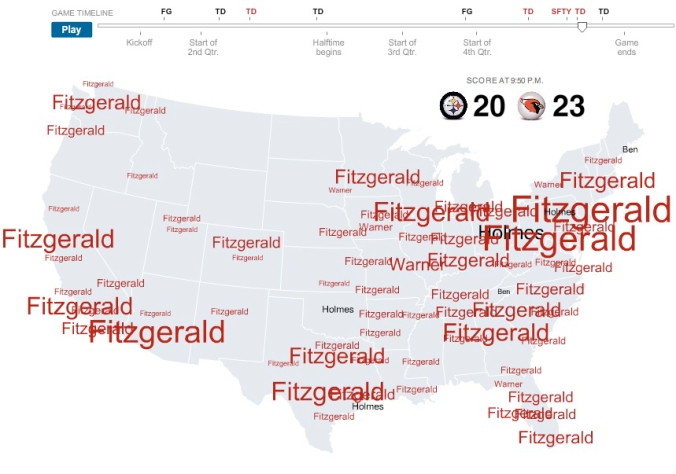About midway through the Spring 2009 semester I decided on a topic to pursue for the coming summer News21 journalism initiative. The topic was broad: Latinos in the military. I decided to do a little research on the Web to see if there were any discussions already brewing.
Last August, I joined the social networking site Twitter, where millions of people share their thoughts about everything and anything. I wanted to know if anyone on Twitter was talking about my topic, so I threw a few word combinations at Twitter’s search engine.
Nothing much came up in my first few searches but eventually I got a few results by searching for “citizenship AND military.” One of the results was particularly interesting. It said:
“My heart breaks for him that can’t go in the military. He should B able to serve the 4 yrs and B given the opportunity to get citizenship.”
The message was posted on April 9 by a user named “Yankeelin” and was the third “tweet” in a series about this individual. Prior messages from the same user said:
“My daughters boyfriend Alberto is from Mexico too. He’s been here since he was 5.”
and
“…and he graduated H.S. as the top ranking ROTC cadet in NC, but his family and him are not legal. So he can’t go in the military!”
I found the story compelling, so I saved the links to the posts and forwarded them in an e-mail to my reporting partner for the summer project. The subject line was: “Maybe we can use Twitter to find stories?”
On May 18th, the first day of the News21 program at Arizona State, I decided to follow up on this story but I wasn’t exactly sure how to proceed. How does one approach a complete stranger on the Internet?
Yankeelin’s Twitter profile revealed that her name was Linda and lived in North Carolina. A White Pages search of her name and hometown returned one result with a phone number, but I decided a less forward method of first contact might be more appropriate in this case.
On Twitter, you can send a message to other users by beginning a message with the “@” symbol followed by the person’s username. One problem with this method is if the user does not log onto the service frequently, he or she could easily overlook this kind of direct message.
The other challenge was that Twitter limits each message you send to 140 characters, 11 of which I would be using up with “@yankeelin” and a space before my message. So cramming an introduction and an explanation and a request to talk was going to be tough to do in 129 characters. However, I managed to squeeze in the following message:
“@yankeelin Im a student studying latinos in milit, love to chat about ur daughters bf Alberto (saw ur tweet from april)- chcameron@gmail.com”
By sacrificing some punctuation (”I’m” became “Im”) and with the use of some well known Internet abbreviations (”ur” for “your” and “bf” for “boyfriend”), I was able to get my message across in exactly 140 characters.
A few days went by and I considered calling the phone number that the white pages search had turned up, but to my surprise, just before noon on May 20, I received an e-mail from Linda in response to my tweet:
“Hi I saw your ‘tweet’ to me about my daughter’s boyfriend wanting to go into the military. You were writing me in reference to a tweet I wrote back in April. My daughter’s e-mail is attached, and the two of you can communicate about it. Her name is Jo Beth.”
A few emails to Jo Beth eventually led to some phone calls with Alberto, the JROTC superstar with dreams of joining the military. He mentioned that his girlfriend had explained how we found him and we shared a laugh over this unorthodox way of reporting.
The more my reporting partner and I chatted with Alberto the more interested we became in his story. Here is a kid who was the top JROTC cadet in the state and all he wants is to serve his country in the military, but he can’t due to his citizenship status.
We pitched his story to our editor and the decision was made: we HAD to talk to this young man. So we booked our flights to North Carolina.
Next thing we knew we were sitting in Alberto and Jo Beth’s living room with two cameras, a lighting kit and a notebook full of questions. We emerged a few hours later having squeezed every last detail out of Alberto and feeling very confident about the story.
As we flew home from the East Coast, it was amazing to think that the opportunity to interview Alberto started with a successful search on Twitter.
Celebrities and others have given Twitter a reputation for obnoxious and pointless messages about what someone ate for breakfast, but in terms of connecting with REAL people with REAL stories, it was the perfect tool.

 The internet is all a’buzz about the brand-spankin’-new iPhone 3GS announced today by Apple, but AT&T users are upset with how the carrier has prepared for its new device. The new phone looks the same, but upgrades to the hardware and a soon-to-come iPhone OS have ushered in a boatload of new features, some of which AT&T won’t be able to provide when the phone launches.
The internet is all a’buzz about the brand-spankin’-new iPhone 3GS announced today by Apple, but AT&T users are upset with how the carrier has prepared for its new device. The new phone looks the same, but upgrades to the hardware and a soon-to-come iPhone OS have ushered in a boatload of new features, some of which AT&T won’t be able to provide when the phone launches. Sarah Lacy
Sarah Lacy

 Earlier this week, in another installment of their infamous product announcements, Apple previewed their
Earlier this week, in another installment of their infamous product announcements, Apple previewed their 


You must be logged in to post a comment.